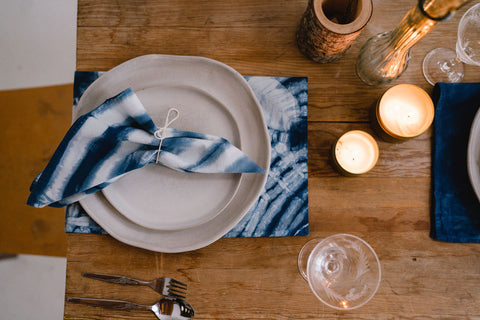
Indigo dye is clearly one of my favourite natural dyes to work with. Firstly I just love the colour. It is one of the truest blues out there and leaves me feeling calm and safe. Second, the process is somewhat magical and relatively simple, at least the one I use. There are many different kinds of indigo vats out there but the one I use in the studio is so reliable and consistent that I hardly deviate. And the third reason is the culture and the history behind it. It is one of the oldest dyes out there and it’s influence spans the globe over the centuries. I don’t claim to be an expert in Indigo but I have studied it in school, travelled to Japan to explore it’s current and historical importance and I have been using it in my studio for over 6 years. It is really one of natures gifts and my goal here is to explain its magic simply so that you have a better understanding and hopefully want to have more of it in your life and maybe even try it out for yourself!
So first and foremost it needs to be understood that indigo comes from a plant. That is why it is called a “natural dye”. Indigofera tinctoria is the latin name which most indigo comes from. It is a green, low lying bushy plant that grows in warm tropical climates. It grows pink flowers and nowhere on the plant is there any blue. You would have no idea from just looking at it that it produces the most rich and deep blues on the planet!

The leaves are picked and are fermented in large vats to convert some of the leaves compounds into the blue dye. The liquid evaporates and a blue “cake” is left which they grind into a powder. This is a very simplified version of the process and many different cultures have their own way of producing the dye but you get the general idea. To get the colour onto the fabric is a whole other process in itself.

Photo credit: Maiwa
Now we have our indigo powder, we need to make a dye stock solution to put into our vat. The problem with the dye powder is that is does not dissolve in water. We add Calcium Hydroxide (calx) to the water to make it soluble and then we add thiourea dioxide to “reduce” the solution, in essence, it removes the oxygen from the liquid. It is this reduction that enables the dye to attach its self onto the fabric.

This is called "Indigo White"
Once the stock solution has properly reduced it is ready for the vat. The vat is where we will be dyeing our fabric. The vat is composed of warm water and small amounts of calx and thiourea dioxide. We gently add the stock solution to the vat, give it a gentle stir and we should see the beginning of the “indigo flower”.

The beautiful healthy "Indigo flower".
Now the vat is ready to dye! The liquid looks green and this is where the magic comes in. We dip the fabric in, leave it for the prescribed amount of time and when we pull it out it is green and then turns blue right before our eyes. This is the oxidization happening. The thiourea removed the oxygen, this allows the dye to attach onto the fibre and then when it get re-oxidizes in the air the colour becomes permanent. The more we dip the deeper the colour gets. Magic!

This magic (actually a fairly simple chemical process haha!) can be applied to any natural fibre; cotton, wool, silk, linen, etc. and can be used in so many different ways. Cultures all across the globe use indigo in their traditional dress and crafts. It is mostly predominant in India, Japan, Africa and Central/South America and even Southern USA. It is one of the oldest know dyes on the planet and they have found evidence of it in Peru from 6000 yrs ago. The original denim jeans were dyed using natural indigo but was soon replaced with a newly crafted synthetic dye in the late 1800’s that eventually dominated the globe in its application and natural indigo was replaced and left for the artists and craftspeople to keep alive.
Indigo dyeing has had a resurgence in the last 20 years. People looking to reconnect with colour and natural dyeing in their crafts and homes. The beautiful indigo colour is eternal in human’s quest to find gentleness, calmness and connection to the natural world around them. To have this colour in our homes is a constant reminder of the water and the skies that surround us. For us to decorate our tables and our living rooms and our kitchens with the comfort of indigo textiles connects us to the rich history of one of the oldest dyes on the planet and to all the cultures that came before us. I encourage you to find an indigo workshop near you so you can experience the magic yourself. Seek out artists who are using natural indigo in their crafts, who are keeping this ancient process alive. You can see all of my indigo collection here if you would like to have some in your home 💙.




